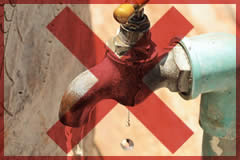Can I Mix Tap Water with Engine Coolant - Vol.302
Antifreeze or an engine coolant is an additive that lowers the freezing point of a water-based liquid, helps water remove excess heat and protects engines from corrosion. It plays a crucial role is cooling systems of modern vehicles.

A typical internal combustion engine only converts one third of its energy into moving the vehicle. The other two thirds are converted into heat. A part of this energy is removed through an exhaust system, leaving approximately one third of total energy produced left in the engine.
The cooling system of a car helps an engine get rid of this energy so that it can produce more energy to move the car. A cooling system consists of passages that are located inside the engine block and engine heads, a water pump that circulates the engine coolant, a thermostat to measure the temperature of the coolant and let it out of the engine when it's hot, and a radiator to cool the coolant.
Water has great cooling features. It needs a coolant additive for two reasons. First, water by itself has a low freezing point. If water were to freeze in the cooling system, the engine would break. Second, water without additives would cause corrosion of the engine and of the cooling system. Engine coolant fluid contains corrosion inhibitors that prevent metal parts from rusting. This is why the recommended ratio of coolant fluid to water mix is usually between 50/50 and 70/30.
This coolant mix follows a circulation path of the cooling system. A water pump pushes coolant from the radiator into passages in the engine block. A water pump usually consists of a fan, a timing belt or a timing chain.
Coolant then flows through the engine, absorbing heat.It also has to pass through a thermostat. A thermostat measures the temperature of coolant. When the engine is cold, the thermostat is closed and it directs the coolant immediately back into the engine, bypassing the radiator.It allows the coolant to reach optimum operating temperature very quickly. Once the coolant's temperature exceeds the optimum temperature, the thermostat opens to allow hot coolant to leave the engine and flowinto the radiator. When the engine is operating at its maximum power, such as driving at a high speeds or up a steel hill, it heats more and the thermostat opens fully.
A radiator consists of a pair of tanks, linked by a core that contains a lot of thin tubes. Because of this, a big percentage of radiator's surface area is used for cooling.
In the past radiators were made of brass or copper cores and had brass headers. Modern radiators mostly have aluminum cores and use plastic headers. While weighting and costing significantly less, such a construction breaks easier and is harder to repair compared to radiators from the past.
When a vehicle is moving, naturally occurring airflows passes on the outside of the radiator tubes, cooling them by doing so. Once the coolant's temperature goes down, the coolant goes back from the radiator into the engine.
Because of this constant movement of the fluid, parts of the cooling system start to corrode with time. Mineral deposits and sediments start to accumulate. This is why it is recommended to flush the cooling system at regular time intervals.
So, Can I Mix Engine Coolant With Tap Water?
No! You should never mix coolant fluid with regular tap water. Tap water contains minerals that can form deposits inside the radiator and cooling system passages of your engine. Use only pure, distilled water.
Always refer to your car's manual and use only the recommended coolant type for your car. This and the proper mixture of coolant and distilled water will help your car and its cooling system run without breaking for a long time.